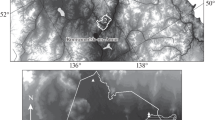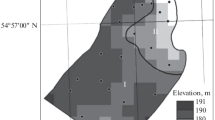Abstract
The impact of the topographic/snow gradient on soil processes in alpinetundra on Niwot Ridge of the Colorado Front Range (Rocky mts, USA) was assessedusinggeostatistical modeling and a fractal approach. The mean snow depth, whichmeasured between 1984 and 2000, exhibited a smooth spatial continuity acrossthestudy grid area (550 × 400 meter). Soil color variables showed a nestedstructure that was attributed to a confounded effect of various soil-formingfactors on catenary processes. The spatial structure of texture classesexhibited no spatial structure and was explained by data sparsity,cryoturbation, and biological processes that mask the expected long-distancevariations (i.e., 550-m) of the catenary processes. Organic C, pH, bulkdensity,and soil moisture content showed various degrees of spatial continuity, but allindicated that the topographic/snow gradient is not the only dominantsoil-forming factor in this alpine ecosystem. The estimated fractal dimensionDfor the grid landform and the mean snow depth varied between 1.2 and 1.4,indicating that they vary smoothly with long-range variation. The estimatedDofthe soil variables ranged between 1.6 and 1.8, showing a noisy appearance withshort-range variations. These results strongly suggest that most small andmicro-scale variations in the alpine soil environs resulted from the combinedeffect of cryoturbation, biological activity, parent-material and eoliandeposition, whereas the large-scale variations originated as a result of thetopographic/snow gradient.
Similar content being viewed by others
References
Barron V. and Torrent J. 1986. Use of the Kubelk-Munk theory to study the influence of iron oxides on soil color. Jour. Soil Sci. 37: 499-510.
Benedict J.B. 1992. Field and laboratory studies of patterned ground in a Colorado alpine region. Occasional Paper No. 49. Institute of Arctic and Alpine Research, University of Colorado, Boulder, CO, USA, 38p.
Bouma J. and van Lanen J.A.J. 1987. Transfer functions and thresholds values: From soil characteristics to land qualities. In: Bech K.J. (ed.), Quantified Land Evaluation. Proc. Worksh. ISSS and SSSA, Washington, DC. 27 Apr.-2 May 1986. Int. Inst. Aerospace Surv. Earth Sci. Publ. no. 6. ITC Publ., Enschede, the Netherlands, pp. 106-110.
Bowman W.D., Theodose T.A., Schardt J.C. and Conant R.T. 1993. Constraints of nutrient availability on primary production in two alpine tundra communities. Ecology 74: 2085-2097.
Bowman W.D. and Conant R.T. 1994. Shoot growth dynamics and photosynthetic response to increased nitrogen availability in the alpine willow Salix glauca. Oecologia 97: 93-99.
Bregt A.K., Bouma J. and Jellinek M. 1987. Comparison of thematic maps derived from a soil map and from kriging point data. Geoderma 39: 281-291.
Burns S.F. and Tonkin P.J. 1982. Soil-geomorphic models and the spatial distribution and development of alpine soils. In: Thorne C.E. (ed.), Space and Time in Geomorphology. Allen & Unwin, London, UK, pp. 25-43.
Burrough P.A. 1994. Principles of Geographical Information Systems for Land Resources Assessment. Monographs on Soil and Resources Survey No 12. Oxford Science Publication, Clarendon Press, Oxford, UK.
Burrough P.A., Bouma J. and Yates S.R. 1994. The state of the art in pedometrics. Geoderma 62: 311-326.
Burrough P.A. 1983. Multiscale sources of spatial variation in soil. I. The application of fractal concepts to nested levels of soil variation. Jour. Soil Sci. 34: 577-597.
Cressie N. 1988. Spatial prediction and ordinary kriging. Math. Geol. 20: 405-421.
Deutsch C.V. and Journel A.G. 1992. GSLIB-Geostatistical Software Library and User’s Guide. Oxford University Press, New York, 340p.
Fisk M.C., Schmidt S.K. and Seastedt T.R. 1998. Topographic patterns of above-and belowground production and nitrogen cycling in alpine tundra. Ecology 79: 2253-2266.
Frank T.D. 1988. Mapping dominant vegetation communities in the Colorado Rocky Mountain Range with LANDSAT thematic mapper and digital terrain data. Photogrammetric Engineering and Remote Sensing 54: 1727-1734.
Goovaerts P. and Chiang C.N. 1993. Temporal persistence of spatial patterns for mineralizable nitrogen and selected soil properties. Soil Sci. Soc. Am. J. 57: 372-381.
Ingersoll R.C., Seastedt T.R. and Hartman M.A. 1997. A Model Information Management System for Ecological Research. Bio-Science 47: 310-316.
Isaaks E.H. and Srivastava M.R. 1989. An Introduction to Applied Geostatistics. Oxford University Press, New York, NY, USA, 561 p.
Litaor M.I. 1987a. The influence of eolian dust on the genesis of alpine soils in the Front, Range, Colorado. Soil Science Society of America Journal 51: 142-147.
Litaor M.I. 1987b. Aluminum chemistry: fractionation, speciation, and mineral equilibria of soil interstitial waters of an alpine watershed, Front Range, Colorado. Geochem. et Cosmochim. Acta. 51: 1285-1295.
Litaor M.I., Mancinelli R. and Halfpenny J. 1996. The influence of Pocket Gophers on the status of nutrients in alpine soils. Geoderma 70: 37-48.
Mandelbrot B.B. 1982. The Fractal Geometry of Nature. Freeman, New York, NY, USA.
May D.E. and Webber P.J. 1982. Spatial and temporal variation of the vegetation and its productivity on Niwot Ridge, Colorado. In: Halfpenny J.C. (ed.), Ecological Studies in the Colorado Alpine. Institute of Arctic and Alpine Research, University of Colorado, Boulder, CO, USA, pp. 35-62.
Mahaney W.C. and Fahey B.D. 1988. Extractable Fe and Al in late Pleistocene and Holocene paleosols on Niwot Ridge, Colorado Front Range. Catena 15: 17-26.
McBratney A.B. and Webster R. 1983. How many observations are needed for regional estimation of soil properties? Soil Sci. 135: 177-183.
Melville M.D. and Atkinson G. 1985. Soil colour: its measurement and its designation in models of uniform colour space. J Soil Sci. 36: 495-512.
O’Lear H.A. and Seastedt T.R. 1994. Landscape patterns of litter decomposition in alpine tundra. Oecologia 99: 95-101.
Scheinost A.C. and Schwertzmann U. 1999. Color identification of iron oxides and hydroxysulfates: Use and limitations. Soil Sci. Soc. Am. J. 63: 1463-1471.
Scheinost A.C., Sinowski W. and Auerswald K. 1997a. Regionalization of soil buffering functions: A new concept applied to K/Ca exchange curves. Advances in GeoEcology 30: 23-38.
Scheinost A.C., Sinowski W. and Auerswald K. 1997b. Regionalization of soil water retention curves in a highly variable soilscape, I. Developing a new pedotransfer function. Geoderma 78: 129-143.
Schulze D.G., Van Scoyoc G.E., Henderson T.L., Baumgardner M.F., Negal J.L. and Stott D.E. 1993. Significance of organic matter in determining soil colors. In: Bigham and Ciolkosz (eds), Soil Color. SSSA Special Publication Number 31. Soil Science Society of America Inc., Madison, WI, USA, pp. 71-91.
Steltzer H. and Bowman W.D. 1998. Differential influence of plant species on soil nitrogen transformations within moist meadow alpine tundra. Ecosystems 1: 464-474.
Taylor R.V. and Seastedt T.R. 1994. Short-and long-term patterns of soil moisture in alpine tundra. Arctic and alpine Research 26: 14-20.
Tietje O. and Tapkenhinrichs M. 1993. Evaluation of pedo-trans function. Soil Sci. Soc. Am. J. 57: 1088-1095.
Walker D.A., Krantz W.B., Price E.T., Lewis B.E. and Tabler R.D. 1994. Hierarchic studies of snow-ecosystem interactions: a 100 year snow alteration experiment. In: Proceedings of the 50th Eastern Snow Conference, pp. 407-414.
Walker D.A., Halfpenny J.C., Walker M.D. and Wessman C.A. 1993. Long-term studies of snow-vegetation interactions. Bio-Science 43: 287-301.
Webster R. and Oliver M.A. 1990. Statistical Methods in Soil and Land Resource Survey. Spatial Information System. Oxford University Press, New York, NY, USA, 316 p.
West A.E., Brooks P.D., Fisk M.C., Smith L.K., Holland E.A., Jaeger C.H. et al. 1999. Landscape patterns of CH4 fluxes in an alpine tundra ecosystem. Biogeochemistry 45: 243-264.
Williams M.W., Brooks P.D. and Seastedt T. 1998. Nitrogen and carbon soil dynamics in response to climate change in a high-elevation ecosystem in the Rocky Mountains, USA. Arctic and Alpine Research 30: 26-30.
Author information
Authors and Affiliations
Rights and permissions
About this article
Cite this article
Iggy Litaor, M., Seastedt, T. & Walker, D. Spatial analysis of selected soil attributes across an alpine topographic/snow gradient. Landscape Ecol 17, 71–85 (2002). https://doi.org/10.1023/A:1015216400909
Issue Date:
DOI: https://doi.org/10.1023/A:1015216400909




